The School of American Ballet’s Workshop Performances / Peter Jay Sharp Theater, Lincoln Center, NYC / June 2 matinee and evening; June 5, 2012
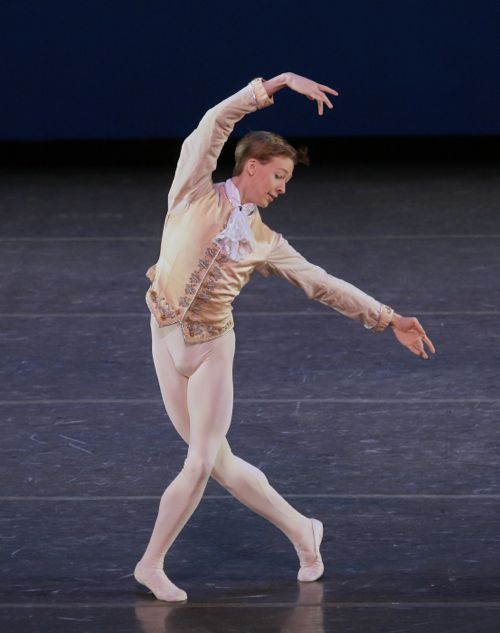 School of American Ballet’s Workshop Performances: Austin Bachman in Peter Martins’ Les Petits Riens
School of American Ballet’s Workshop Performances: Austin Bachman in Peter Martins’ Les Petits Riens
Photo: Paul Kolnik
Students at the School of American Ballet and the in-group that cares about it call it, simply, The School, as if it had no equals. So far it doesn’t, at least in the States. It’s the training academy of the New York City Ballet, which skims off the cream—according to its particular needs and taste, of course—and releases the others to companies across the United States and sometimes around the world. Every spring it presents three of what it calls Workshop Performances (same program, alternating casts in the principal roles) so those interested can get a good look at the teen-age pre-professionals, for many of whom the very next step is to find a job.
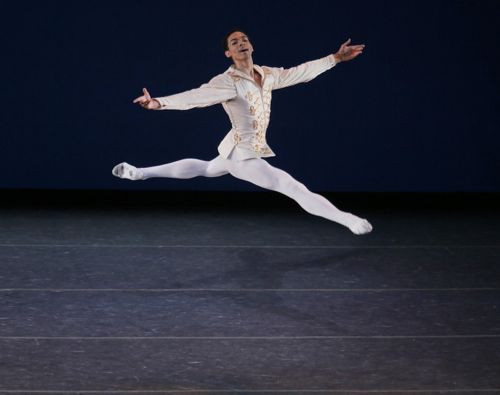 Silas Farley in George Balanchine’s Cortège Hongrois
Silas Farley in George Balanchine’s Cortège Hongrois
Photo: Paul Kolnik
As usual, once a spectator recovers from the shock of seeing these painstakingly trained and lavishly accomplished late adolescents, he or she will recognize—or at least sense—the particular qualities of an SAB “product.” At SAB, some of them shepherded from childhood as well as through adolescence, the students learn what the celebrated 18th-century dance artist Jean-Georges Noverre itemized as the basics of dancing: to bend, to stretch, to rise, to leap, to dart, to glide, to turn. They learn to perform infinite elaborations of these basics with exactitude, profound musicality, grace, style, and assurance—all effort concealed. (George Balanchine, who established the school even before forming his first company, understood dancing as the work of angels, anonymous and transcendent.)
This year’s Workshop offered two challenging ballets, Balanchine’s Cortège Hongrois and Les Petits Riens (Little Nothings) by Peter Martins, who heads the school as well as the parent company. I saw two performances—the matinee and evening shows on July 2.
Cortège Hongrois was created for the New York City Ballet in 1973 to honor the veteran ballerina Melissa Hayden on the occasion of her retirement. Juxtaposing the classical- and character-dance veins, it was the choreographer’s most extended take on Marius Petipa’s 1898 Raymonda, set to a Glazounov score that, once heard, has you humming its high points for weeks, often against your will. Petipa’s ballet was an imaginary account of a highborn young woman in the Middle Ages—lovely, proud, and emotionally susceptible—who can’t decide which of her two suitors to favor: the pure Christian knight (good guy) or the sexy Saracen (bad guy).
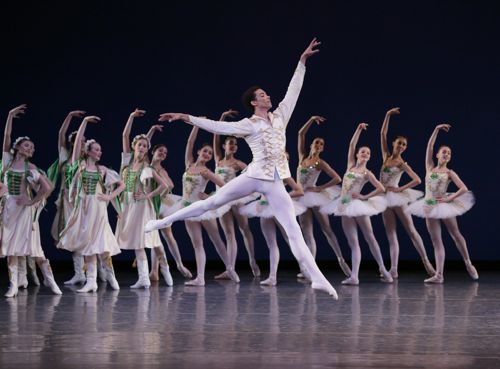 Silas Farley and members of the character- and classical-dance ensembles in Balanchine’s Cortège Hongrois
Silas Farley and members of the character- and classical-dance ensembles in Balanchine’s Cortège Hongrois
Photo: Paul Kolnik
Balanchine had already dealt with the material better, notably in his brisk, all-classical Pas de Dix. Cortège, however, was a vehicle eminently suited for Workshop because it provided roles to three dozen dancers in the two contrasting styles. And, defying all expectations of tedium, the ballet was ignited by the young dancers’ verve. Responsibility for staging the piece was split between Suki Schorer (classical) and Susan Pilarre (character); both, former dancers with City Ballet, are stalwarts in the development of SAB’s advanced students.
The classical segments of the ballet were performed by students working far beyond their years (no one in the whole program yet qualified as a twentysomething). The technical requirements were very well mastered; the aplomb was continuously amazing.
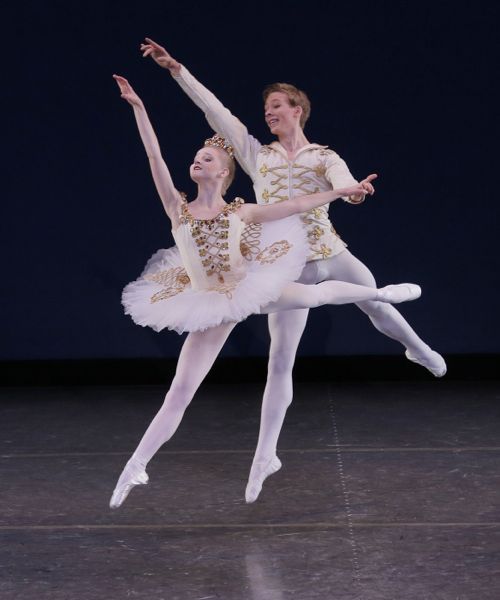 Claire von Enck and Austin Bachman as the leading classical-dance pair in Balanchine’s Cortège Hongrois
Claire von Enck and Austin Bachman as the leading classical-dance pair in Balanchine’s Cortège Hongrois
Photo: Paul Kolnik
Balanchine chose to keep his Cortège choreography abstract, avoiding any reference to narrative and character. Still, both the women I saw in the leading role gave her interpretation a subtext, which presumably taught the many little girls in the audience how a princess-type—especially one with “issues”—should behave. Claire von Enck and Austin Bachman, who led the evening’s cast, topped the matinee pair (Mikayla Lambert and the wonderful Silas Farley) but when I’d only seen the matinee cast, I didn’t think anything was missing.
As for Bachman, I’ve been watching him and marveling since he arrived at SAB as a boy. He’s blessedly capable all round: jumps, leaps, turns—the whole vocabulary. Clear in every step, he’s soft and airy as well. His skill as a partner is still minimal, but that’s probably due to inexperience. He has the most beautiful and elastic feet, which shoot him into the air and, even more important, enable neat, cushioned landings. He has the face of a shy country boy unaware of his charm, and the good manners that prevent him from over-estimating his importance. If he continues to be diligent and lucky, he’s likely to go down in the history books.
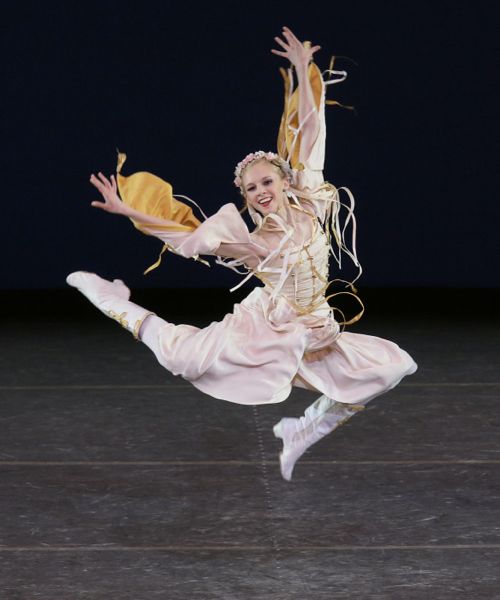 Elinor Hitt, leading the character-dance segment in Balanchine’s Cortège Hongrois
Elinor Hitt, leading the character-dance segment in Balanchine’s Cortège Hongrois
Photo: Paul Kolnik
Although dancers usually prefer to play royalty than peasantry, the character work in this production of Cortège glowed with vehemence and joy. The booted dancers in their preposterously fringed costumes looked as if they were participating in a lusty ritual they believed in wholeheartedly. Dancing the female lead in the character dances at the matinee, Elinor Hitt, a rail-thin blonde who doesn’t look as if she grew up in America, was a standout. (The house program insists that her home town is Arlington, Virginia.)
Peter Martins’ Les Petits Riens (Little Nothings) uses its title ironically. Named for its score (Mozart’s only music intended for ballet) and given its premiere by City Ballet in 1987, it’s a pretty big deal, which SAB’s young cast brought off deftly. Though a chamber work in scale (four couples), it poses a slew of technical challenges as Martins, typically, explores how far he can take the academic vocabulary—along with his specific gift for men’s work and special fascination with partnering—without flouting tradition entirely. The verdict proves to be “pretty damned far.” That doesn’t mean, though, that the spectator is having a good time, let alone undergoing a transformative experience. For those small miracles you have to go to Balanchine.
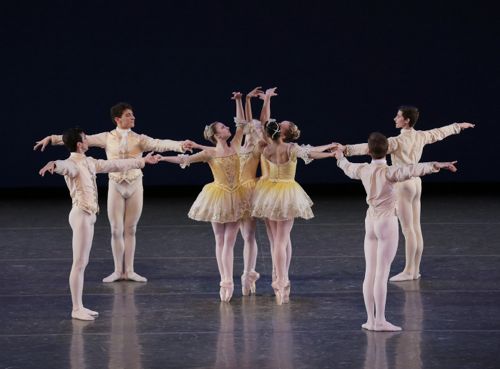 The full cast of Martins’ Les Petits Riens
The full cast of Martins’ Les Petits Riens
Photo: Paul Kolnik
The craft Martins displays is refreshing—until the craftiness becomes annoying or, simply, a bore. The fact that, as in several Martins works, there is no main couple, adds to the loss of affect; ballet is, by its very nature, a hierarchical world. Worse, Martins seems not to have been in the studio back when Mr. B. declared for the umpteenth time, “Put a man and a girl on the stage and there is already a story.” For all his invention and his understanding of what a male dancer might accomplish, Martins appears to lack the human-interest gene.
The ambitious Workshop program had a curtain raiser, Sean Lavery’s 1990 Twinkliana, set to Mozart’s Twelve Variations on Ah! vous dirai-je, maman (the tune to which Americans sing the “Twinkle, Twinkle Little Star” lullaby). The ballet is both an entertainment and a lesson, illustrating the various stages of a dancing youngster’s development. Its revival just now is a bow to Lavery’s long, varied, and significant service to City Ballet and its school. Of course I remember him best as a classical dancer, in particular in Balanchine’s Tschaikovsky Concerto No. 2 (formerly Ballet Imperial). I can still envision him at a particular moment in that work, when he deploys two strings of women, one from each hand, and maneuvers both chains of pliable beauties so that they curl softly this way and that at his ever-gentle yet compelling demand. I’ve always thought of this passage as “Balanchine’s Dream.”
© 2012 Tobi Tobias




As usual a point on a critique by Ms. Tobias. Even though my own choreography for the New York City Ballet and years later for my own Los Angeles Ballet did not always receive a positive response from her, Ms. Tobias nevertheless knows her stuff. One of my favorite roles was as the cavalier of the “classical” couple. I even got to partner Melissa Hayden at her last performances with the company in this ballet. What memories and what a great ballet!
Offhand, I’d be hard pressed to point to an image that captures (and conveys!) pure joy more thoroughly than the shot of Elinor Hitt in “Cortege Hongrois.” Here’s wishing her and her classmates the brightest of futures.
I was amazed by the picture of Elinor Hitt too. Paul Kolnik really outdid himself with it.
I loved this review and that snippet about Noverre itemizing the basics: to bend, to stretch, to rise, to leap, to dart, to glide, to turn; and Balanchine’s notion of dancing as the work of angels, anonymous and transcendent. I’d like to be able to do all that in everyday life.
Thank you for your insightful review and analysis, which adds immensely to this ballet fan’s appreciation of the art. During the Saturday matinee, I had the unexpected and very special privilege of sitting next to Silas Farley’s best friend and fellow dancer from North Carolina as well as his former teacher and head of the school he attended there. In addition to being thrilled at seeing and feeling his artistry, wonderful partnering and exquisite line, I benefited from the added bonus of speaking with his teacher and hearing her observations about his superb gifts, which she recognized when he was very young. (Alas, I have forgotten her name.) I am a devoted attendee at NYCB and hope, hope, hope that we will be seeing Mr. Farley there very soon.
Oh, I loved this review. You made me feel as if I were sitting right there with you during these Workshop Performances. Thanks once again!
That is a brilliant-and instructive-review of SAB’s Workshop of 2012, the highlight of this balletomane’s ballet year. Tobi nails all that I too saw in these young dancers. The staging , the costumes, the orchestra, and, of course, the dancers combined to create an astoudingly beautiful show. Brava and Bravo. We sat near Peter Martins (I prefer his wife, Darci Kistler) and he was applauding wildly at the end. I wish I could have seen the evening show, but the mmatinee was pure joy.
Thanks, Tobi for all that news. I can picture them so vividly.
Here’s what I wrote about SF Ballet’s school performance:
http://www.ebar.com/arts/art_article.php?sec=dance&article=205